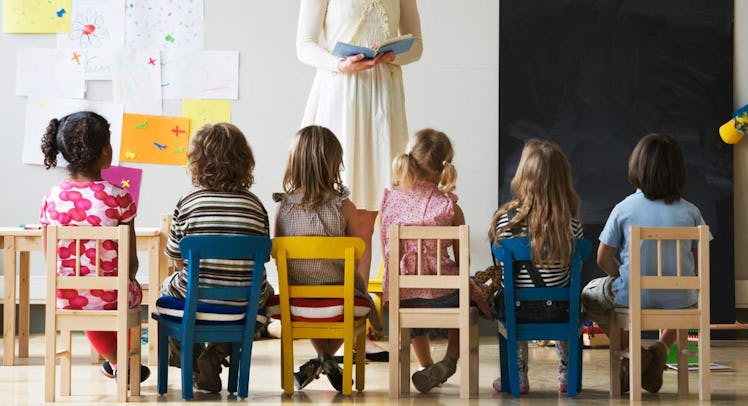Enough With All This Pre-K Panic
Despite New York's universal Pre-K, parents still put themselves through a lot of needless stress.

In my part of Brooklyn — a decidedly yuppie enclave with a highly rated elementary school that serves as a magnet for well-to-do young families — 4/20 brought apocalyptic news. With just 54 pre-K seats available for the coming school year, our five-star school can’t accommodate every Jasper, Jackson, and Chloe in the 60 square blocks its zoned to serve.
Though it was posted clearly on the school’s website, this seating shortfall caught many parents by surprise. In the words one of local blogger, they were left “scrambling” when their first choice wasn’t honored.
Meanwhile, life at the Koyen household was exceptionally chill. Our son, R, was offered a spot at our first choice. His new school is spacious, well-equipped, and staffed with friendly, attentive teachers and administrators. It’s in walking distance and offers late pick-up for a very modest fee.
But it’s also on the wrong side of the tracks.
Or, to be literal, the wrong side of a highway overpass that separates our part of “Brooklyn” from a neighborhood that looks, well, more like Brooklyn. To the best of my knowledge, R is the only kid from his daycare to attend. Among the “scrambling” parents I’ve asked, some plan to haul their kids on the subway every morning to their second and third choices, neighborhoods away. Others will continue to pay $2,000 a month for daycare, rather than make the unthinkable journey to the bad side of town.
Fuck that. New York City’s universal pre-K (UPK) is an incredible feat of political engineering. In 2013, then-mayoral candidate Bill de Blasio’s campaigned on UPK; since taking office, he’s kept his word. With nearly 70,000 4-year-olds attending free pre-K, New York City operates, as the New York Times put it “one of the nation’s most ambitious experiments in education.”
And, yes, it’s free for everyone. Elsewhere in the U.S., government-funded programs might benefit just lower-income and disadvantaged families. With full-time daycare costing anywhere between $1,000 and $2,000 a month, de Blasio’s “experiment” has been a godsend for the vast majority of New Yorkers.
There’s one hitch. Because our UPK is still evolving, zoned enrollment is not guaranteed. In other words, every four-year-old is guaranteed a free pre-K education — somewhere. That’s one reason why New York’s subways are packed with stroller-pushing parents during the morning rush hour. They’re dropping their toddlers a few neighborhoods away, then racing to work.
By design, my wife and I live in a lovely part of Brooklyn known for its great public schools. Of course, we’re not the only parents who know how to google school rankings. Ours is a neighborhood where the bars are overrun with families during happy hour. Until 8 p.m., the world belongs to us. When the sun goes down, we give way to the singles on the prowl and child-free couples on dates.
With R turning four this year, January arrived with the looming specter of applying for pre-K. This is no simple task. New York City’s Department of Education is one of the city’s great mysteries, a massive institution whose inner workings are so frustrating that a cottage industry of consultants exists to help parents navigate it.
Even without expert help, it didn’t take long for us to get hip to the bad news: Unless hell froze over and pigs took wing, our boy would not be attending pre-K his local elementary school.
We performed the due diligence expected of us. We hopped on the subway and toured other schools where more seats were available. They were fine, if uninspiring, but each would require pushing a stroller onto the crowded subway every morning. We’d do it if need be. Second only to the cable bill, I truly loathe our monthly daycare bill.
Then, poring over the pre-K map, I noticed a small red dot tucked beneath the overpass that serves as the border between two Brooklyns. We scheduled another tour, met another set of teachers, smiled as yet more preschoolers played with finger paints and fought over alphabet blocks.
Wikimedia Commons
In other words, it was a perfectly fine facility with the same books, toys, and teachers we’d seen elsewhere. It’s also not an official public school, but rather a small community-based preschool that’s incorporated into the pre-K system. As a result, they get the same funds per-student as everyone else.
Even if that weren’t the case, money isn’t our only consideration when it comes to R’s education. Just ask my wife about her fancy private school growing up. She was born in Kansas City, but her family moved back to India when she was in grade school. Because her father cared deeply about appearances, she was sent to an expensive Catholic school in Delhi. In addition to learning about Jesus for the first time, she endured more than just stern lectures at the hands of the classically trained nuns.
So, sometime in September, my four-year-old boy will say goodbye to the warm, welcoming bosom of his stupidly expensive yuppie daycare. With his half-Indian skin, he’ll no longer be the darkest kid in class. And, to be sure, that’s a good thing. Our decision wasn’t only about saving a shit ton of time and money; even among four-year-olds, bubbles don’t build good citizens.
And anyway, what’s at stake? Even at the best pre-K, a good day is learning a new dinosaur name, taking a long nap, and not shitting your pants. My kid can handle that.
This article was originally published on